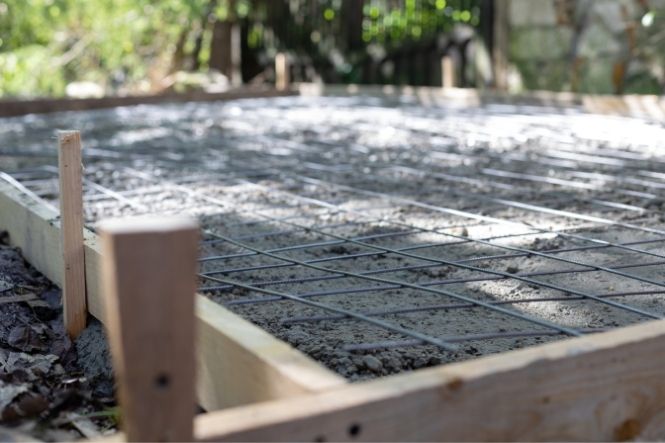Formwork is essential for making driveways, particularly if the concrete is to be poured on. Let’s face it, only the very shortest driveways are going to be constructed by shovelling on barrow loads of concrete by hand.
What is Formwork?
This refers to the barriers erected at the borders of a driveway to hold the cement in place while it dries. It needs to be securely held, not only laterally but vertically, so that the mass of concrete doesn’t push it out of line or tip it over. Once the slab has set the formwork is usually removed.
Formwork is also used on gradients to hold the concrete back and prevent it sliding down. There are limits to this though and only shallow gradients can successfully have slabs of concrete poured using edge formwork. Concrete driveways on steeper gradients need different construction methods and aren’t covered in this article (see our article Calculating the Fall on your Driveway).
Road Forms
Commercial contractors use metal sections called ‘road forms’, which are a bit like smaller versions of barriers used on the central reservations of motorways. The sections are generally straight, although gently curved ones are also available.
They are pegged into the ground and each section is clipped to its neighbour. They are strong enough to withstand the attention of vibrating compactors and other machinery that contractors use to bed down a concrete slab.
Domestic Formwork
However, road forms are not that easily available to domestic users. Although some hire shops do carry them for the DIY driveway maker, they are probably overkill. It’s more usual to manufacture the formwork you need from timber and plywood or some other sort of board.
Be aware that knocking an old plank into the ground and supporting it with pegs will lead to a very poor finish, even if the plank stays upright while the concrete is curing. Timber formwork needs a wide base to prevent it from tipping over, and a decent face (usually made from all-weather plywood) that will withstand moisture and won’t stick to the concrete.
Timber Formwork Construction
This means that timber formwork is usually constructed from 2×2 or 2×4 timbers top and bottom, linked by noggins at 1-2ft (30-60cm) intervals. Then triangular braces are made to go behind the frame and hold it precisely vertical. The framework is then faced with the plywood, resulting in a stable and strong structure, which isn’t too heavy to move into position.
Using Formwork for Concrete Driveways
Make sure the formwork is securely held. If the drive borders reasonably soft ground, pin the formwork down at the back with stakes that are at least 1ft (30cm) long.
If there is a solid surface adjacent to the driveway, such as another expanse of concrete or other paving, try to secure the formwork vertically by placing heavy weights at the rear. Then secure it laterally by timber cut to length to rest against a solid surface, such as a nearby wall.
Economising on the Carpentry
Depending on the layout of your driveway, and the prevailing weather, you may be able to get away with just making two pairs of long straight forms and moving them to a new position as each section of slab cures to some extent.
This won’t work particularly well if you want to get the whole driveway laid in a weekend, but it could be suitable if you are prepared to spread the work out over a period of time.
Release Agents
Don’t forget to treat the face of the formwork with a release agent. If you don’t, the edge of the driveway will break away in clumps or bits of the formwork face will stick to the concrete. Ask for release agent, often known as soap oil, when you buy the concrete and sand from the builders’ merchant.

